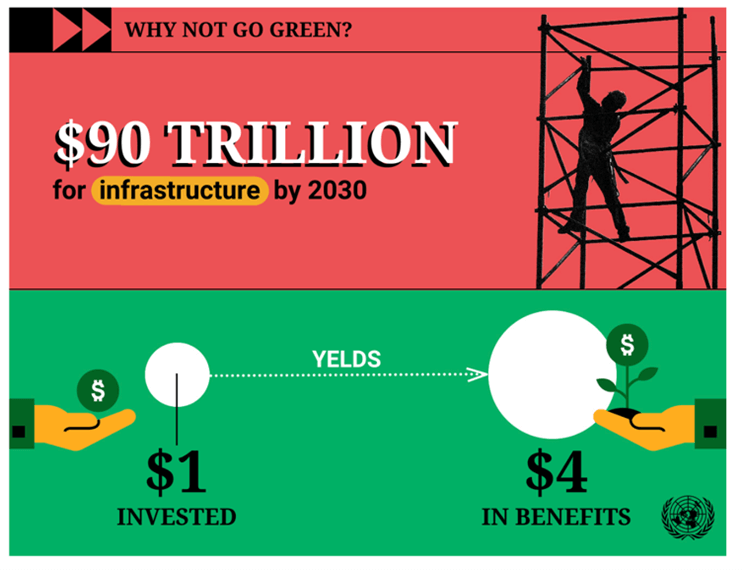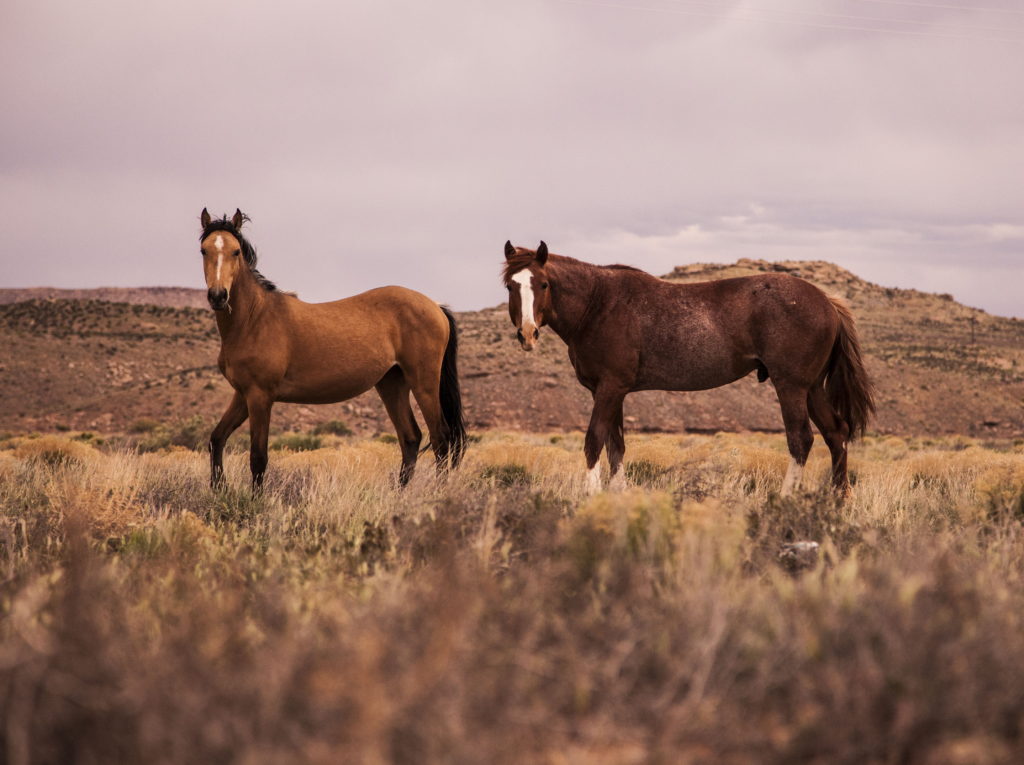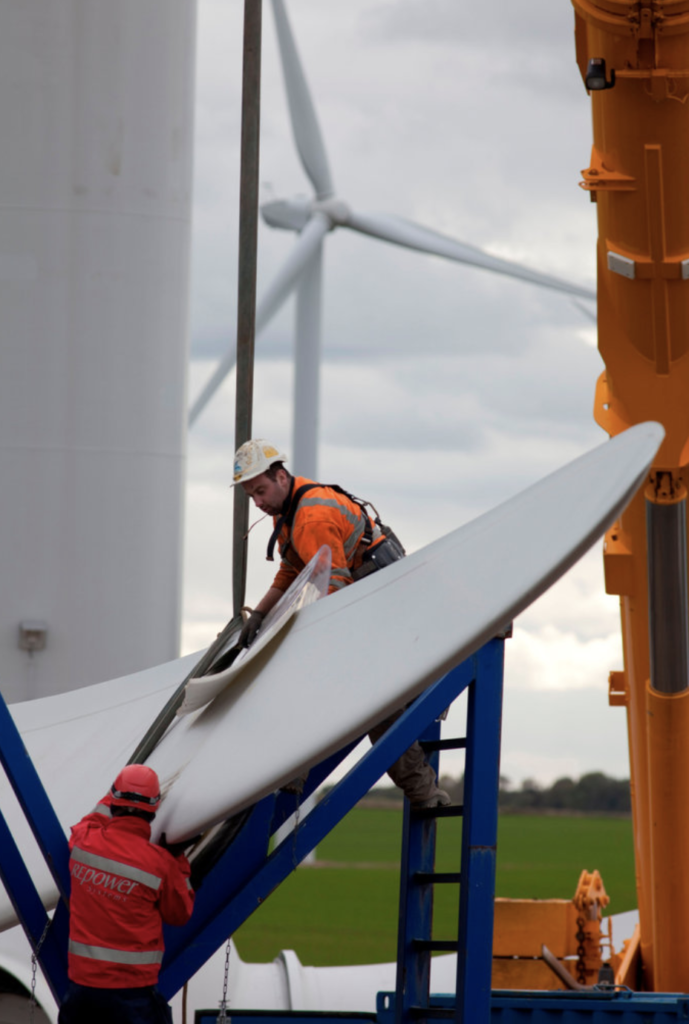Menu
This is a great question about the cost of taking the action needed on climate change. This is something governments, economists and policy makers everywhere have been thinking about and calculating. It has also been something that those who would prefer to delay taking action on climate change have talked about a lot, saying that the costs of taking action are too large.
Certainly, the costs of decarbonising the global economy are great. The UN calculates that globally, US$125 trillion of investment is needed to achieve net zero by 2050. This is almost $200 trillion, in today’s currency, in Australian dollars. For perspective, about US$453 trillion (AU$720 trillion) of wealth exists in the global economy today. Most investment will be needed in technology for renewable electricity generation, so that we can move away from using fossil fuels for electricity. Currently, globally, we put US$600 billion (AU$953 billion) into decarbonising electricity. By the 2030s, this will need to be $2.2 (AU3$.5) trillion annually.
Related to the cost of decarbonisation, we need to think about the impact climate action would have on jobs. There are estimates that getting to net zero could mean the loss of 187 million jobs globally by 2050. However, there are also projected to be 202 million new jobs, given the need for new large-scale investment in renewable energy.
These are all large figures, that are hard to imagine, however, the best way to think about the cost of climate action is to set it against the cost of not taking action. We know unchecked climate change will mean more extreme weather disasters, reduce the amount of food the world produces, threaten infrastructure, raise insurance costs and claims and, force large numbers of people to migrate, all increasingly damaging economies. Although there is much difficulty and uncertainty about predicting a cost of inaction, one estimate is that not acting on climate change would cost US$178 trillion (AU$283 trillion) globally over the next 50 years. Research has been telling us ever more clearly that the costs of inaction are greater than the costs of action. By not acting, we will also miss out on the investment, innovation and jobs that the global transformation to clean energy will bring. Even more importantly, investing early in climate action will actually have economic benefits. The UN estimates that for every US1$ invested in the ‘green economy’ there will be $4 of benefits.

Therefore although we hear much about the cost of dealing with climate change, it’s wrong to say that the cost of acting to keep temperatures down is too much. In fact, it’s the other way around: if we act now we could be better off, globally, and if we delay action, dealing with climate change will cost us much more in the long run.
Antarctica is melting around the edges where it touches the relatively warm ocean. Climate change is making the ocean warmer, and it is very unlikely that this will change anytime soon. We expect that the ice covering Antarctica will continue to melt, and will probably melt even faster in the future. If we act swiftly enough there is a chance that the melt will slow down or even reverse, but that chance is dwindling every day.
Yes, whilst much more is known about bigger species’ responses to climate change scientists are now also beginning to discover how mushrooms are affected.
Mushrooms are a type of fungus. Fungi (plural of fungus) are a group of living things that also include mould and yeast. Fungi like to eat organic material such as fallen trees and old fruit (think of the kinds of environments you have seen mushrooms growing. Fungi can't move on their own so they reproduce by spreading their spores. Many types of mushrooms and other fungi also spread their spores by producing fruiting bodies during autumn. The “fruiting body” is actually the mushroom that you and I can see.
Climate change is now affecting when and for how long these fruiting bodies are produced. Scientists don’t understand everything yet – but they are learning that climate change is making some mushrooms produce their fruiting bodies either earlier or later than normal. Scientists also don’t know what this might mean for ecosystems, but it is likely that there will be changes in how some animals and birds and insects can feed on mushrooms as their growth timing changes.
Fungi may also play a big role in helping to reduce climate change! Some fungi live in symbiosis with trees. Symbiosis means that a tree and fungus have a close relationship to each other and may provide each other with benefits such as food or habitat. We all know trees can help sequester carbon dioxide from the atmosphere – but some species of fungi are help trees to absorb CO2 even faster.

What an interesting question! As a mode of transport, compared to cars, horses definitely produce fewer emissions and so are better for the environment!
But if we had a horse for every family to use to travel around in that might not be good for the environment, because of the increased need for land to grow their food and it would not be helpful to clear land to grow grass for horses.

Horses burp methane just like cows and sheep so from that perspective horses aren’t so good for the environment. But horse manure can be used to produce energy! So horses are good for the environment in some ways and not so good in other ways.
We are using modern technology to combat climate change, but not to its full potential (yet). There is still more that could be achieved with solar power technology, batteries, alternatives to plastics and recycling, among many other things. Some exciting and innovative new ideas include paint that can convert energy from the sun – which could then be used on roads or on houses.
There are also efforts underway to produce fully biodegradable plastic alternatives, from seaweed or plant fibres. We also have a lot of exciting development happening in electric cars and infrastructure for solar charging stations. This will all help us move away from a reliance on fossil fuels, which is the main cause of climate change.
As well as helping us to reduce the causes of climate change, modern technologies can also help us to adapt to the changes climate change will bring. We can use models and satellites to predict extreme events ahead of time so we can plan ways to reduce the impacts. Farmers can use technology to help them plant crops more suited to future climate. We can also use technology to build houses that are more energy efficient, and plan new developments in ways that take into account climate change.
Modern technology is a useful part of our response to climate change, but we also https://www.youtube.com/watch?v=Ci6LKz0ajfI&t=7sneed to do other things too, like reducing our consumption (see Curious Climate Schools what can I do?). Climate change needs a range of responses, we can’t rely on technology alone.
There definitely could be. Marine plants, like land plants, need light for photosynthesis. But unlike on land, light can only penetrate into the surface of the ocean, about 100m deep. Now, marine plants, known as phytoplankton, live in the surface ocean where there is light. However, when the ocean gets cold is gets denser. That dense (heavier) water the sinks mixing phytoplankton down deeper into the ocean, sometimes so deep there isn’t any light.
In a warming climate the ocean won’t get as cold, and in turn might not mix as deep. This would give phytoplankton access to more light and could allow them to be more productive and therefore provide more food for marine animals as well.
However, there are many other factors at play. For example, phytoplankton also need nutrients which are mor common at depth, so less mixing could mean less nutrients. Their predators (zooplankton) also may be able to eat them faster in a warmer ocean. So, the net effect of climate change on marine plants is still unknown. As for the animals, more plant productivity could be a good thing, but even that would come with major shifts in the timing in location of when and where the plants grow, which could create a major ecological problem.
Thanks for asking about whether there are positives from climate change. What a great question! Climate change is posing real challenges for people and for nature but not everything is negative everywhere. The most obvious changes in nature include our findings that plants and animals are moving into areas where those particular species have not been before. This is because areas further away from the equator are becoming warmer and allowing tropical and subtropical animals to move into temperate areas, and those in temperate areas to move into polar areas. In fact, polar regions in the Arctic and Antarctica are “greening” with the arrival of larger plants.
A good example of animal arrivals in Tasmania is that Yellowtail Kingfish can be caught off the east coast of Tasmania throughout more of the year than in the past. A citizen science project, Redmap, lets fishers log their unusual catches so that scientists can find out about these species on the move! Also, over the last 20 years, the long spine (dark blue/black) sea urchin has arrived from southern New South Wales to become very important in rocky reef systems around Tasmania. These changes have occurred because climate change is causing changes in ocean circulation and the East Australia Current has been penetrating Tasmanian waters further and for longer throughout the year than in the past.

Understanding whether these changes in distribution of animals and plants is a good thing or not depends on the effects those species have in their new environment. For example, Yellowtail Kingfish live in open water parts of the ocean that have a specific temperature range. Moving to a new open water place does not change much for the tuna or the life around it. However, the sea urchins for example live on the sea floor and are moving into areas where there are other species that already live there. These other species, like abalone or rock lobster, are negatively affected by the urchin as the urchin devours large amounts of algae and causes change in the rocky reef habitat.
How can a sea urchin move from New South Wales to Tasmania if it lives on the sea floor? Most animals and plants in the ocean have two phases in their life cycle – a larval phase (like a tadpole) and the adult phase. Sea urchin larvae can survive in the surface of the ocean for many weeks before they settle to the sea floor. So, larvae from sea urchins in NSW can travel on the East Australia Current and then settle in Tasmania.
You could read more about how species are responding to climate change here: https://theconversation.com/climate-driven-species-on-the-move-are-changing-almost-everything-74752
This is such a good question, as it shows you are thinking about that fact that all sources of energy, whether renewable or non-renewable (like fossil fuels) have some emissions associated with them.
We all know well that fossil fuels are a real problem because of the large amounts of greenhouse gases they emit when burned. We can turn to renewable energy as an alternative – things like solar, wind and hydro. However, these technologies also have some carbon emissions associated with them. For example, if we think of a wind turbine, while the power it generates is low carbon, it’s not zero carbon. Carbon dioxide emissions are generated throughout a wind turbine’s life cycle, from mining the raw materials to build it, to its manufacture, construction, maintenance and also decommissioning at the end of the turbine’s “life”.

Did you know hydroelectric dams, particularly in tropical areas, can also have significant methane emissions associated with them, due to vegetation rotting under the dam’s water for several years after dams are first flooded? Methane is a powerful greenhouse gas, meaning that even hydroelectricity isn’t entirely “emissions free”.
Though no energy source is “perfect” in terms of carbon emissions, the carbon emissions associated with renewable energy sources over their life cycles are much, much lower than emissions from burning fossil fuels. In the near future, we may be able manufacture things like the steel for wind turbines not using fossil fuel but instead, using green hydrogen, making life cycle emissions of renewable energy sources even lower.
You asked about mitigating emissions from all energy sources: this is where the role of carbon sinks and offsets comes in. Even when we reach “net zero”, there will still be some emissions. Net zero means achieving an overall balance between greenhouse gas emissions produced, and greenhouse gas emissions taken out of the atmosphere, for example by trees and natural environments. When we are able to achieve that balance, then we will be doing really well – so that energy we consume in our daily lives won’t have a detrimental effect on our atmosphere and on the planet.